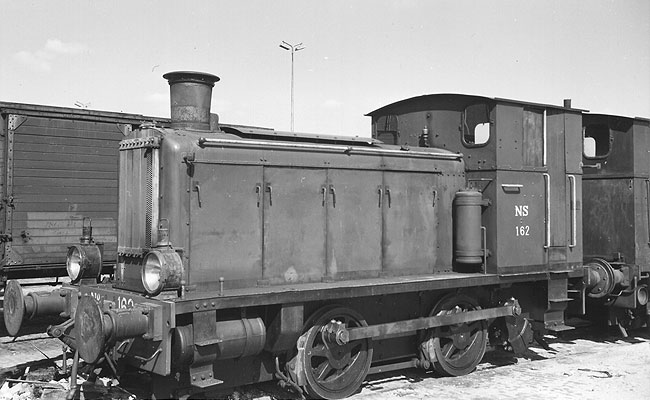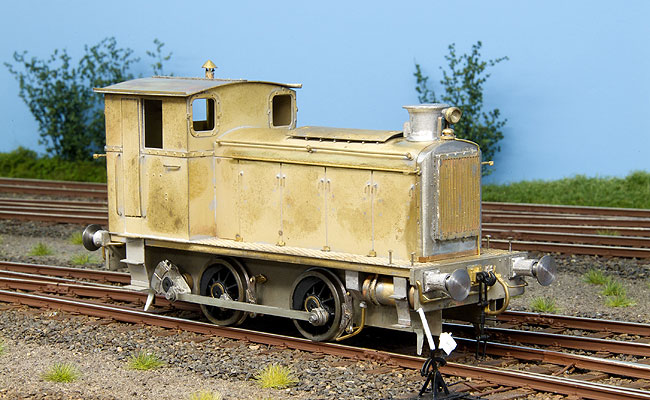War child: the NS 162

The NS 162 is one of a series of small diesel locomotives that were built for the British War Department by Vulcan Foundry Ltd (commisioned by Drewry Cars) and Andrew Barclay in 1941. The locomotive was assigned number WD 70033 and it entered service as a shunter for military trains in the UK. About a week after D-Day, WD 70033 came ashore via Utah Beach. It was the second allied forces locomotive to be deployed in France. It was used to repair the railways and to transport men and equipment .
After the surrender of Nazi Germany in May 1945 the locomotive was more or less left behind in Nijmegen, The Netherlands. The Westlandsche Stoomtramweg Maatschappij (WSM) - a rural tram company in the west of the country - was interested in buying it, but its low topspeed of 28 km/h was regarded a problem. The Nederlandsche Tramweg Maatschappij (NTM) - a similar company from the north - took a different view and brought the WD 70029, 70033, 70040, 70041 and 70045 in 1946 to Friesland.
The NS - Dutch State Railways - acquired the NTM and its equipment in 1947, including the former WD locomotives. They were assigned numbers 161-165 and continued working the northern branch lines. As the country slowly emerged from the devastation of the war faster and stronger were required. In 1956 the remaining locomotives were replaced by the much stronger NS 450 series.
Some locomotives were scrapped, but the NS 162 and 165 were sold to the coal mine Willem-Sofia. The NS 162 remained in service until the closure of the mine in 1971. Both locomotives were acquired by contractor Frans Vanderbossche for use on a scrap yard. NS 165 was scrapped itself and used for parts to keep the NS 162 rolling. Finally the NS 162 ended up as a monument in front of the contractor's yard. As the last of its kind it was bought by the Stibans foundation in 1996. Restoring the locomotive could begin. Thanks to the 162 Foundation we can see it running on Dutch tracks again in the near future. A few similar ex-WD locomotives have been preserved in the UK.

The NS 162 is small but unqiue part of the national railway history and it is fun to build such a historic model. Because it is originally a Britisch locomotive, there was a kit of its British counterparts from Mercian Models. As usual with kits like these you have to order the wheelsets, motor and gears seperately.
The kit's price is modest, but the same can be said about the instructions. Luckily the first steps are clearly documented, so the chassis, cabin and bonnet were quite easy to assemble. The axles and wheels were bought from Slater's. The wheels are about accurate in size, but they lack the counterweights and the number of spokes is wrong. But it is the best available.

The axles are mounted rigidly in the frame. Although I took great care in assembling the chassis not all the wheels are on the track at all times. This does not help to get the locomotive running smoothly. The best solution is a technique called compensation. One axle is mounted in hornblocks and can travel up and down in the chassis. The locomotive's weight rests on the centre of the axle. The other axle is mounted in two bearings as it was. Like a three-legged chair the locomotive is now always stable on the track. The hornblocks were also ordered from Slater's.

I sand-blasted the model when I was done with the bigger parts. The chassis clearly shows the hole for the hornblocks. As the project progresses it becomes more and more a matter of improvisation. There are quite a few small differences between the locomotives used in The Netherlands and those used in the UK. It is vital to get hold of as much photos of the prototype as you can for reference.
What did I have to change? The handles on the bonnet doors were too thick; I used 0.5 mm brass wire instead of 1.0 mm wire. The bonnet doors had extra holes for handles that are present on British locomotives, but not on the Dutch ones. So I had to fill them with solder. The buffer beams were fitted with grips and an air hose for breaking.
Many of the white metal parts turned out to be wrong. The radiator has to be a lot thicker and I made a new one from brass. The conneting rods do not fit together smoothly. It took a lot of work to get the locomotive running.

A fellow O gauge modeller, Hans Nijntjes, was able to machine several new parts from brass for me. He made new lanterns, an additonal chimney, air tanks and much more. I soldered the chassis and the bigger parts, but I glued the smaller ones. Before you know it adding an extra part means loosing a couple of other ones.

The locomotive viewed from both sides. The air tanks in the kit are too small and they were replaced by bigger ones from brass. Brakes were added and enhanced with extra details. The radiator cap is also an extra detail made by Hans. With some extra work you can turn the kit into a much better model.

The model is done for about 90%. I am still missing a few details like oil lamps, a whistle and rear sand boxes. When I have found or made those parts, the locomotives can be finished, painted and motorised.
2010